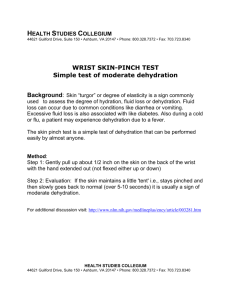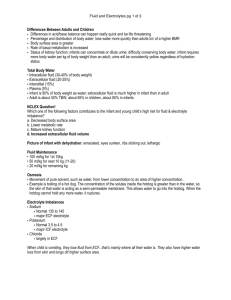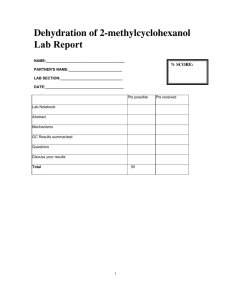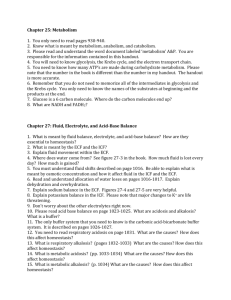ABP Renal and Electrolyte Board Specifications 2011
advertisement
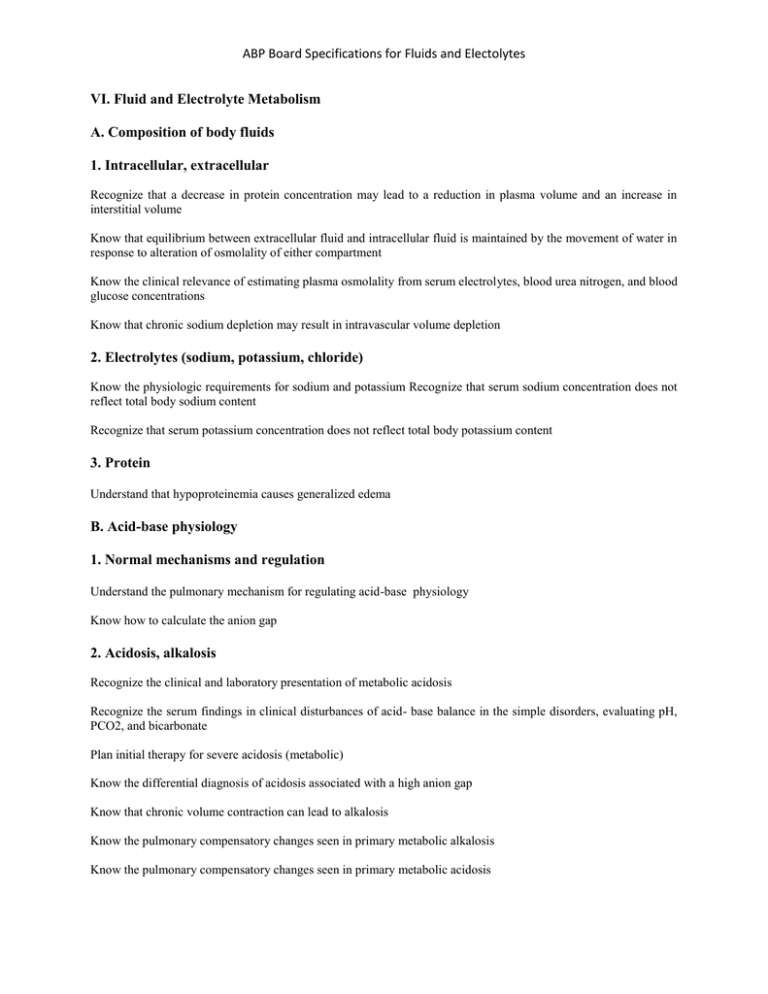
ABP Board Specifications for Fluids and Electolytes VI. Fluid and Electrolyte Metabolism A. Composition of body fluids 1. Intracellular, extracellular Recognize that a decrease in protein concentration may lead to a reduction in plasma volume and an increase in interstitial volume Know that equilibrium between extracellular fluid and intracellular fluid is maintained by the movement of water in response to alteration of osmolality of either compartment Know the clinical relevance of estimating plasma osmolality from serum electrolytes, blood urea nitrogen, and blood glucose concentrations Know that chronic sodium depletion may result in intravascular volume depletion 2. Electrolytes (sodium, potassium, chloride) Know the physiologic requirements for sodium and potassium Recognize that serum sodium concentration does not reflect total body sodium content Recognize that serum potassium concentration does not reflect total body potassium content 3. Protein Understand that hypoproteinemia causes generalized edema B. Acid-base physiology 1. Normal mechanisms and regulation Understand the pulmonary mechanism for regulating acid-base physiology Know how to calculate the anion gap 2. Acidosis, alkalosis Recognize the clinical and laboratory presentation of metabolic acidosis Recognize the serum findings in clinical disturbances of acid- base balance in the simple disorders, evaluating pH, PCO2, and bicarbonate Plan initial therapy for severe acidosis (metabolic) Know the differential diagnosis of acidosis associated with a high anion gap Know that chronic volume contraction can lead to alkalosis Know the pulmonary compensatory changes seen in primary metabolic alkalosis Know the pulmonary compensatory changes seen in primary metabolic acidosis ABP Board Specifications for Fluids and Electolytes Know the renal compensatory changes seen in primary respiratory acidosis ABP Board Specifications for Fluids and Electolytes Know the renal compensatory changes seen in primary respiratory alkalosis Know which diuretics produce metabolic alkalosis Know which diuretics produce metabolic acidosis Formulate a differential diagnosis of acidosis with a normal anion gap C. Electrolyte abnormalities 1. Sodium a. Hypernatremia Know that extracellular fluid volume is relatively spared in hypernatremia Know the symptoms of hypernatremia b. Hyponatremia Recognize diseases associated with hyponatremia and increased sodium in the urine Know the causes of factitious hyponatremia Recognize the importance of urinary sodium concentration and urinary osmolality in the differential diagnosis of hyponatremia Know that chronic diuretic therapy can produce hyponatremia Recognize the importance of estimation of sodium intake and output in evaluating patients with hyponatremia Distinguish between dilutional hyponatremia and a total body deficit of sodium 2. Potassium a. Hyperkalemia Know the emergency treatment of hyperkalemia Recognize that severe cardiac rhythm changes may begin abruptly in patients with hyperkalemia Know the signs of hyperkalemia Plan the treatment for a patient with hyperkalemia b. Hypokalemia Recognize the development of hypokalemia in a patient with gastroenteritis Recognize the electrocardiographic rhythm abnormalities in patients with hypokalemia Know the emergency treatment of hypokalemia Know the symptoms of hypokalemia ABP Board Specifications for Fluids and Electolytes 3. Chloride Recognize the association of chloride and acidosis in the differential diagnosis of metabolic acidosis Recognize the need for a urinary screening examination for diuretics in the evaluation of hypochloremia D. Disease states, specific therapy 1. Pyloric stenosis Recognize that the differential diagnosis of metabolic alkalosis includes pyloric stenosis Recognize the acid-base changes seen in pyloric stenosis, and manage appropriately 2. Gastroenteritis Plan the management of acute gastroenteritis 3. Acute renal failure Know the changing fluid requirements in patients with severe oliguria Know that coexisting volume depletion should be corrected in patients with acute renal failure 4. Shock Recognize the clinical signs of shock due to fluid loss Know the type of fluids to be administered in the treatment of shock Recognize that frequent clinical assessment is required in the treatment of shock Recognize that immediate fluid resuscitation of infants in shock may require more than 20 mL/kg of fluid to improve their clinical conditions 5. SIADH Recognize the serum and urine abnormalities in SIADH Recognize the clinical abnormalities associated with SIADH Know the treatment of SIADH Know that plasma volume is increased in SIADH Recognize how to differentiate SIADH from hyponatremic dehydration Recognize disease conditions and medications associated with SIADH Understand the importance of fluid restriction in the management of SIADH Understand that head trauma can lead to diabetes insipidus or SIADH ABP Board Specifications for Fluids and Electolytes 6. Cystic fibrosis Recognize the hypochloremic/hyponatremic dehydration seen in cystic fibrosis 7. Dehydration Recognize the clinical and laboratory abnormalities of hyponatremic dehydration Recognize the clinical and laboratory abnormalities of hypernatremic dehydration Recognize the laboratory abnormalities of isotonic dehydration Know how to manage hypernatremic dehydration Know how to manage hyponatremic dehydration Know how to manage isotonic dehydration Understand the effectiveness of oral rehydration solutions in treating acute diarrheal dehydration Understand the differences between and rationale for the composition of oral rehydration solutions Know that hypotension is a very late sign of dehydration Know that the signs and symptoms of dehydration are related to changes in extracellular fluid volume Know that intracranial hemorrhage may occur during the development of hypernatremic dehydration Recognize the possibility of seizures in an infant with chronic hypernatremia who is being rapidly rehydrated Understand how to differentiate diabetes insipidus from hypernatremic dehydration (ie, urine specific gravity, urine and serum osmolalities) 8. Hyperosmolar non-ketotic coma Plan appropriate fluid therapy for a patient with hyperosmolar non-ketotic coma to prevent the development of cerebral edema VI. Fluid and Electrolyte Metabolism A. Composition of body fluids 1. Intracellular, extracellular Recognize that a decrease in protein concentration may lead to a reduction in plasma volume and an increase in interstitial volume Know that equilibrium between extracellular fluid and intracellular fluid is maintained by the movement of water in response to alteration of osmolality of either compartment Know the clinical relevance of estimating plasma osmolality from serum electrolytes, blood urea nitrogen, and blood glucose concentrations ABP Board Specifications for Fluids and Electolytes Know that chronic sodium depletion may result in intravascular volume depletion 2. Electrolytes (sodium, potassium, chloride) Know the physiologic requirements for sodium and potassium Recognize that serum sodium concentration does not reflect total body sodium content Recognize that serum potassium concentration does not reflect total body potassium content 3. Protein Understand that hypoproteinemia causes generalized edema B. Acid-base physiology 1. Normal mechanisms and regulation Understand the pulmonary mechanism for regulating acid-base physiology Know how to calculate the anion gap 2. Acidosis, alkalosis Recognize the clinical and laboratory presentation of metabolic acidosis Recognize the serum findings in clinical disturbances of acid- base balance in the simple disorders, evaluating pH, PCO2, and bicarbonate Plan initial therapy for severe acidosis (metabolic) Know the differential diagnosis of acidosis associated with a high anion gap Know that chronic volume contraction can lead to alkalosis Know the pulmonary compensatory changes seen in primary metabolic alkalosis Know the pulmonary compensatory changes seen in primary metabolic acidosis Know the renal compensatory changes seen in primary respiratory acidosis Know the renal compensatory changes seen in primary respiratory alkalosis Know which diuretics produce metabolic alkalosis Know which diuretics produce metabolic acidosis Formulate a differential diagnosis of acidosis with a normal anion gap C. Electrolyte abnormalities 1. Sodium a. Hypernatremia ABP Board Specifications for Fluids and Electolytes Know that extracellular fluid volume is relatively spared in hypernatremia Know the symptoms of hypernatremia b. Hyponatremia Recognize diseases associated with hyponatremia and increased sodium in the urine Know the causes of factitious hyponatremia Recognize the importance of urinary sodium concentration and urinary osmolality in the differential diagnosis of hyponatremia Know that chronic diuretic therapy can produce hyponatremia Recognize the importance of estimation of sodium intake and output in evaluating patients with hyponatremia Distinguish between dilutional hyponatremia and a total body deficit of sodium 2. Potassium a. Hyperkalemia Know the emergency treatment of hyperkalemia Recognize that severe cardiac rhythm changes may begin abruptly in patients with hyperkalemia Know the signs of hyperkalemia Plan the treatment for a patient with hyperkalemia b. Hypokalemia ABP Board Specifications for Fluids and Electolytes Recognize the development of hypokalemia in a patient with gastroenteritis Recognize the electrocardiographic rhythm abnormalities in patients with hypokalemia Know the emergency treatment of hypokalemia Know the symptoms of hypokalemia 3. Chloride Recognize the association of chloride and acidosis in the differential diagnosis of metabolic acidosis Recognize the need for a urinary screening examination for diuretics in the evaluation of hypochloremia D. Disease states, specific therapy 1. Pyloric stenosis Recognize that the differential diagnosis of metabolic alkalosis includes pyloric stenosis Recognize the acid-base changes seen in pyloric stenosis, and manage appropriately 2. Gastroenteritis Plan the management of acute gastroenteritis 3. Acute renal failure Know the changing fluid requirements in patients with severe oliguria Know that coexisting volume depletion should be corrected in patients with acute renal failure 4. Shock Recognize the clinical signs of shock due to fluid loss Know the type of fluids to be administered in the treatment of shock Recognize that frequent clinical assessment is required in the treatment of shock Recognize that immediate fluid resuscitation of infants in shock may require more than 20 mL/kg of fluid to improve their clinical conditions 5. SIADH ABP Board Specifications for Fluids and Electolytes Recognize the serum and urine abnormalities in SIADH Recognize the clinical abnormalities associated with SIADH Know the treatment of SIADH Know that plasma volume is increased in SIADH Recognize how to differentiate SIADH from hyponatremic dehydration Recognize disease conditions and medications associated with SIADH Understand the importance of fluid restriction in the management of SIADH Understand that head trauma can lead to diabetes insipidus or SIADH 6. Cystic fibrosis Recognize the hypochloremic/hyponatremic dehydration seen in cystic fibrosis 7. Dehydration Recognize the clinical and laboratory abnormalities of hyponatremic dehydration Recognize the clinical and laboratory abnormalities of hypernatremic dehydration Recognize the laboratory abnormalities of isotonic dehydration Know how to manage hypernatremic dehydration Know how to manage hyponatremic dehydration Know how to manage isotonic dehydration Understand the effectiveness of oral rehydration solutions in treating acute diarrheal dehydration Understand the differences between and rationale for the composition of oral rehydration solutions Know that hypotension is a very late sign of dehydration Know that the signs and symptoms of dehydration are related to changes in extracellular fluid volume Know that intracranial hemorrhage may occur during the development of hypernatremic dehydration Recognize the possibility of seizures in an infant with chronic hypernatremia who is being rapidly rehydrated Understand how to differentiate diabetes insipidus from hypernatremic dehydration (ie, urine specific gravity, urine and serum osmolalities) 8. Hyperosmolar non-ketotic coma Plan appropriate fluid therapy for a patient with hyperosmolar non-ketotic coma to prevent the development of cerebral edema
